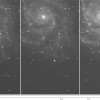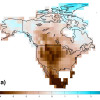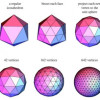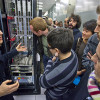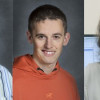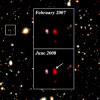News
Closest Type la Supernova in Decades Solves a Cosmic Mystery
Type Ia supernovae (SN Ia’s) are the extraordinarily bright and remarkably similar “standard candles” astronomers use to measure cosmic growth, a technique that in 1998 led to the discovery of dark energy – and 13 years later to a Nobel Prize, “for the discovery of the accelerating expansion of the universe.” The light from thousands of SN Ia’s has been studied, but until now their physics – how they detonate and what the star systems that produce them actually look like before they explode – has been educated guesswork. Read More »
A Better Way to ID Extreme Weather Events in Climate Models
You’d think that spotting a category 5 hurricane would never be difficult. But when the hurricane is in a global climate model that spans several decades, it becomes a fleeting wisp among mountains of data. Read More »
Today’s Severe Drought, Tomorrow’s Normal
While the worst drought since the Dust Bowl of the 1930s grips Oklahoma and Texas, scientists are warning that what we consider severe drought conditions in North America today may be normal for the continent by the mid-21st century, due to a warming planet. Read More »
Supercomputers Take a Cue from Microwave Ovens
As sophisticated as modern climate models are, one critical component continues to elude their precision—clouds. Simulating these fluffy puffs of water vapor is so computationally complex that even today’s most powerful supercomputers, working at quadrillions of calculations per second, cannot accurately model them. Read More »
Berkeley Lab Reaches Out to Women in Computing
Although women comprise the majority of the United States labor force, 60 percent of college graduates in developed countries, most of the of Internet users, and start the majority of new companies created each year in the US, they have made surprisingly few inroads into high performance computing, according to a recent HPC Wire editorial. Berkeley Lab is working to increase the number of women in computer science and HPC applying to work at the Lab. Read More »
New Scientific Networking Division Created as Home to ESnet
ESnet, the U.S. Department of Energy’s Energy Sciences Network, will become the core of the newest scientific division at Lawrence Berkeley National Laboratory, Berkeley Lab Director Paul Alivisatos announced Monday, Nov. 21. The new scientific networking division will report to Kathy Yelick, Associate Laboratory Director for Computing Sciences. Read More »
Computing Tools Speed Search for New Porous Materials
A team of researchers from Lawrence Berkeley National Laboratory and the University of California at Berkeley are building a suite of computational tools to help in the search for new porous materials. These synthetically created materials can play key roles in physical and chemical processes, including petroleum refinement, water softening and in separations. One class, known as zeolites, has a commercial impact of about $350 billion annually. Read More »
Berkeley Lab to have Strong Presence at SC11 Conference
Once again, scientists and engineers from Berkeley Lab are making significant contributions to the SC11 Technical Program, sharing their expertise and experience with thousands of attendees at the annual conference sponsored by the IEEE Computer Society and ACM SIGARCH. SC11 will be held Nov. 12-16 in Seattle.SC11 Technical Program Sessions with Berkeley Lab Contributors TECHNICAL PAPERSThe SC11 Technical Papers program received 352 high quality submissions covering a variety of advanced… Read More »
Ten Billion Light Years Away, A Gang of Supernovae Reveals a Cosmic Secret
An international team of astronomers has exposed the largest sample of distant supernovae ever found—150 events, many of which are located about 10 billion light years away from Earth. These events reveal that a particular breed of cosmic explosions, called Type 1a supernovae, occurred five times more frequently when the universe was young than they do today. The paper, authored by a team of American, Israeli and Japanese astronomers, was published in the October 2011 issue of Monthly Notices of the Royal Astronomical Society (MNRAS). Read More »
Accelerating Advanced Material Development
New materials are crucial to building a clean energy economy—for everything from batteries to photovoltaics to lighter weight vehicles—but today the development cycle is too slow: around 18 years from conception to commercialization. To speed up this process, a team of researchers from the Department of Energy’s Lawrence Berkeley National Laboratory (Berkeley Lab) and the Massachusetts Institute of Technology (MIT) teamed up to develop a new computational tool. Called the Materials Project, it launches this month. Read More »







 Instagram
Instagram YouTube
YouTube